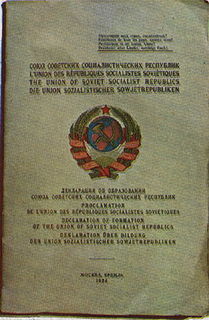An Autonomous Soviet Socialist Republic (ASSR) of the Union of Soviet Socialist Republics was a type of administrative unit in the Union of Soviet Socialist Republics (USSR) created for certain nations. The ASSRs had a status lower than the union republics of the USSR, but higher than the autonomous oblasts and the autonomous okrugs.

The Uzbekistan national football team represents Uzbekistan in association football and is controlled by the Uzbekistan Football Association, the governing body for football in Uzbekistan. Uzbekistan's home ground is Milliy Stadium in Tashkent and their current head coach is Vadim Abramov.

The Spartakiad was an international sports event that was sponsored by the Soviet Union. Five international Spartakiades were held from 1928 to 1937. Later Spartakiads were organized as national sport events of the Eastern Bloc countries. The games were organised by Red Sport International.

The Soviet national ice hockey team was the national ice hockey team of the Soviet Union. The team won nearly every world championship and Olympic tournament between 1954 and 1991 and never failed to medal in any International Ice Hockey Federation (IIHF) tournament they competed in.
The State Prizes of the Soviet Republics were each republic counterpart to the USSR State Prize. Each republic granted several different prizes, generally named after writers or artists from the republic, as well as a blanket Komsomol prize for young artists.
Autonomous oblasts of the Union of Soviet Socialist Republics were administrative units created for a number of smaller nations, which were given autonomy within the fifteen republics of the USSR.

Viktor Izrailyovych (Illich) Kanevskyi was a Ukrainian and Soviet football player and coach. He was Jewish.

Rugby union in the Soviet Union was a moderately popular sport. It was most popular in the Georgian SSR; parts of the Russian SFSR such as Moscow and certain regions in Siberia like Krasnoyarsk; and Alma-Ata, the capital of the Kazakh SSR. Rugby enjoyed a more limited popularity in the Ukrainian SSR, Minsk in the Byelorussian SSR and parts of the RSFSR such as Leningrad and areas in Southern Russia, including Krasnodar. Rugby gained a significant following due to the vast size of the Soviet Union, but was never a major sport; despite many attempts to develop the sport, which Soviet citizens came to nickname the "leather melon" due to the shape of the ball. Still, an early championship in 1960 gives an idea of the sheer scale of Soviet rugby: one hundred teams from over thirty cities took part.

The Russian Soviet Federative Socialist Republic, previously known as the Russian Soviet Republic and the Russian Socialist Federative Soviet Republic, as well as being unofficially known as the Russian Federation, Soviet Russia, or simply Russia, was an independent state from 1917 to 1922, and afterwards the largest, most populous and most economically developed of the 15 Soviet socialist republics of the Soviet Union (USSR) from 1922 to 1990, then a sovereign part of the Soviet Union with priority of Russian laws over Union-level legislation in 1990 and 1991, during the last two years of the existence of the USSR. The Russian Republic comprised sixteen smaller constituent units of autonomous republics, five autonomous oblasts, ten autonomous okrugs, six krais and forty oblasts. Russians formed the largest ethnic group. The capital of the Russian SFSR was Moscow and the other major urban centers included Leningrad, Novosibirsk, Yekaterinburg, Nizhny Novgorod and Samara.

The Georgian men's national ice hockey team is the national men's ice hockey team of Georgia, and a member of the International Ice Hockey Federation (IIHF) since 8 May 2009. As of May 2018, Georgia is ranked 40th in the World Ranking. Georgia first played in the World Championships tournament in 2013, and remained at Division III level until winning at that level in 2018 and earning a promotion to Division II Group B.

The Kyrgyzstan national ice hockey team is the national ice hockey team of Kyrgyzstan. They are controlled by the Ice Hockey Federation of the Kyrgyz Republic and has been an associate member of the International Ice Hockey Federation (IIHF). Kyrgyzstan is ranked 52nd in the IIHF World Ranking and made its World Championship debut in 2019.
1990 Baltic League was organized in 1990. The league consisting of 17 clubs from the Lithuania SSR, Estonian SSR, the Latvian SSR and FC Progress Cherniakhovsk from Kaliningrad Oblast.

The State Emblem of the Soviet Union was adopted in 1923 and was used until the dissolution of the Soviet Union in 1991. Although it technically is an emblem rather than a coat of arms, since it does not follow traditional heraldic rules, in Russian it is called герб, the word used for a traditional coat of arms.
The Spartakiad of the Peoples of the USSR was a mass multi-sport event in the Soviet Union which lasted from 1956–1991. The competition was a descendant of the international Spartakiads, named after the classical escaped slave leader Spartacus. The USSR Spartakiad comprised two separate quadrennial competitions: the Summer Spartakiad and the Winter Spartakiad. The competitions were conducted between the constituent Republics of the Soviet Union.

The Treaty on the Creation of the USSR officially created the Union of Soviet Socialist Republics (USSR), commonly known as the Soviet Union. It de jure legalised a union of several Soviet republics that had existed since 1919 and created a new centralised federal government where key functions were centralised in Moscow.

The Tajik Autonomous Soviet Socialist Republic was an autonomous republic within the Uzbek SSR in the Soviet Union. It was created in October 1924 by a series of legal acts that partitioned the three existing regional entities in Central Asia – Turkestan ASSR, Bukharan People's Soviet Republic, and Khorezm People's Soviet Republic – into five new entities based on ethnic principles: Uzbek SSR, Turkmen SSR, Tajik ASSR, Kara-Kirghiz Autonomous Oblast, and Karakalpak Autonomous Oblast.
The football tournament at the 1986 Spartakiad of Peoples of the USSR was a preparatory competition for the Soviet Union Olympic football team among the Olympic reserves. The competition took place on July 9 through July 27, 1986 as part of the Spartakiad of Peoples of the USSR.














